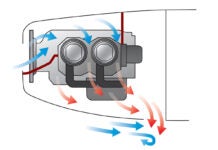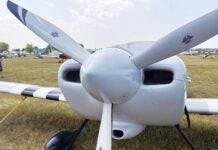The aerodynamic characteristics of the wing have a dramatic effect on the performance of an airplane. How big to make the wing is one of the most fundamentally important decisions a designer must make. Several factors help determine the proper wing size for an airplane, and all must be considered to achieve a good design.

Performance
The designers goal is to make the airplane perform as well as possible, but what really constitutes good performance is not a simple question. It is important to design the airplane to perform well in the real world, when it is flown the way it will normally be operated.
Unfortunately, at least in the homebuilt world, there is a strong tendency to advertise and compare airplanes on the basis of top speed. Because airplanes with normally aspirated engines achieve their highest maximum speed at sea level, many homebuilts are designed with wings sized to give high top speeds at low altitude. The designers apparently calculate their performance based on the atmospheric properties that occur at sea level on a standard day and use these calculations to size the wing.
Sizing the wing this way may give some impressive sounding speed numbers to put in an advertising brochure, but it does not give the best airplane for several reasons. First, real-world airplanes spend most of their time flying at density altitudes well above sea level. This is particularly true in the western part of the country where the ground is often many thousands of feet above sea level, and the temperatures can be much higher than standard. Even in the east, where the ground is not so high, airplanes do not routinely travel cross-country on the deck. Most cross-country flights in unpressurized airplanes occur at density altitudes between 5000 and 12,000 feet. Turbocharged airplanes with pressurization or on-board oxygen equipment cruise as high as 20,000 feet.
A second important consideration is that airplanes do not cruise at maximum speed. We cruise light airplanes at power settings between 65% and 75% of rated power. For optimum cruise performance a normally aspirated airplane is flown at the highest altitude where its engine can produce cruise power. For a 75% power setting this is a density altitude of about 8000 to 9000 feet. If the wing is sized for sea level maximum speed, it will be mismatched to the way the airplane is normally operated. In service, the airplane will almost always be flying higher, and at a lower power setting than those for which the wing was optimized.
To illustrate how wing size affects performance lets turn our attention to an example. Figure 1 shows how density altitude affects the optimum wing size for a 2000 pound gross weight airplane flying at an airspeed of 150 knots true. The airfoil and other drag characteristics for this example are typical of a clean single-engine airplane. The aspect ratio is kept constant for this example; only the wing area changes.
The sea-level-optimized airplane has a wing area of only 67.5 square feet and a wing loading of almost 30 pounds per square foot. An airplane optimized for a 9000-foot cruise altitude has a wing area of 89 square feet and a wing loading of 22.4 pounds per square foot. If we increase our cruising altitude to 18,000 feet, we find an optimum wing area of about 120 square feet and a wing loading of 16.6 pounds per square foot.
Figure 2 compares the power required to overcome the drag of the airplane as a function of the airspeed for two airplanes flying at sea level on a standard day. One has the sea-level optimized wing (small wing) just discussed, and the other has the wing optimized for 9000-foot density altitude (large wing).
Notice first that the small-wing airplane requires less power to fly at 150 knots (our design optimization speed) than the large-wing airplane. The other thing to notice is that the difference is extremely small, only about 1.5 horsepower. That is less than 2% of the total required, and corresponds to a speed penalty for the large-wing airplane of about a knot. The second thing to notice is that the small-wing airplane requires more power to fly at any airspeed below about 140 knots, even at sea level.
Now lets look at Figure 3, which compares the same two airplanes flying at a density altitude of 9000 feet. At our design speed of 150 knots, the large-wing airplane requires slightly less power to fly than the small-wing airplane. The difference is good for about 2 knots speed difference in favor of the larger wing. It is only at airspeeds above 160 knots that the smaller wing has less drag.
If we were to look at even higher altitudes, we would see the trends continue. The higher you go, the more advantage a larger-wing airplane has in cruise performance. Increasing the speed at which we optimize also increases the difference between a sea-level-optimized airplane and a cruise-altitude-optimized one.
Stall Speed
As we have seen, properly sizing the wing for cruise altitude for a normally aspirated airplane produces a small benefit in cruise performance over an airplane with a wing sized for sea-level cruise. The difference is not large, but the larger-wing airplane does go a bit faster at a realistic cruise altitude. For a turbocharged airplane that cruises at higher altitudes, the difference is larger.
Cruise speed is not the only consideration, however. Figure 4 shows flaps-down stall speeds for the two airplanes we’ve been comparing. The one with the wing designed for sea level stalls at 69.5 knots, while the larger-wing airplane with the wing optimized for 9000 feet stalls at just under 61 knots. If we were trying to certify this airplane under FAR Part 23, the large-wing version would be acceptable, and the small-wing one would not.
Homebuilt airplanes in the United States do not have to meet the FAR Part 23 stall-speed requirements. Even so, the 8.5-knot difference in stall speed is quite significant to the operator of the airplane. The takeoff roll is proportional to the square of the liftoff speed. If both airplanes have the same power, then the small-wing airplane will use 30% more runway length to take off. The same will hold for the ground roll after touchdown.
Keeping stall speed down is also important for safety. One of the most important factors in the survivability of uncontrolled arrivals at the ground is speed. The faster you are going at impact, the poorer the chance of survival. The FAA did not pick the 61-knot stall speed for single-engine airplanes at random. If we look at crash survivability information, we find a strong knee in the curve at about 61 knots. If the pilot maintains control, and the impact is relatively flat, the odds are that the occupants will survive if the speed is in the 61-knot range or below. As impact speed increases above about 65 knots things quickly get worse. By the time the speed is above 70 knots, nothing short of a perfectly flat touchdown on a smooth surface is survivable.
The small increase in sea level speed is not worth the cost in safety and takeoff and landing performance. The larger-wing airplane is only a bit faster at altitude, but it does do better. Far more important, it takes off and lands shorter and is safer in the event of a forced landing.
In cases where the stall speed is specified at the outset, either by regulations or by a mission requirement, it is common to have the wing size driven by the stall-speed requirement. For the range of stall speeds generally required of light aircraft, the wing will tend to be bigger than a performance-optimized wing.
Climb
Looking again at Figure 2, we can see that the small-wing airplane requires more power to fly than the large-wing version at airspeeds typical of takeoff and climb. At 80 knots the difference is just over 15%. Rate of climb is proportional to the excess power available from the engine and propeller. Excess power is the power available over and above the power required to maintain level flight. The large-wing airplane will have about 8 more excess horsepower than the small-wing one. It will have a rate of climb that is about 130 feet per minute higher at sea level.
The rate of climb of both airplanes will drop off with increasing altitude, but the small-wing airplane will run out of rate of climb at a lower altitude. Its ceiling will be several thousand feet lower than the large-wing machine. Particularly in the western part of the country, where high density altitudes are common, this can be important.
Weight Growth
Almost all airplane designs tend to get heavier as time progresses. The stripped-down prototype is followed by better-equipped versions with nicely appointed interiors and attractive but heavy paint jobs. Often larger engines, increased fuel capacity and even retractable gear appear, and all of these things add weight. If the wing area of the prototype is marginal, then there is no capacity to accommodate the increased weight. A little extra wing area leaves room to carry the inevitable extra poundage.
Summary
Changing the size of the wing has two effects on drag. Increasing wing area increases wetted area and hence parasite drag. If the aspect ratio is held constant, it also increases the wingspan, which reduces induced drag. Which effect is larger depends on the flight condition. At low altitude and high speed, parasite drag tends to dominate. As altitude increases or speed decreases, induced drag becomes more important. Induced drag is inversely proportional to wingspan squared, so a relatively small increase in the wingspan can make a large difference in the rate of climb. At altitude, it can also have a large enough positive effect on cruise drag to overcome the parasite drag penalty of the larger wing area.
Making the wing too small for the aircraft is a common design error on high-performance homebuilts. It is less common on certified airplanes because the stall speed set by the FARs prevents the designer from shrinking the wing beyond a certain point. If the surface of the wing is smooth, then the increased wetted area of a larger wing is aerodynamically cheap. Trying to squeeze the last square inch of wing area out in search of speed will result in an airplane that is not much faster at best and may even be slower at a realistic cruise altitude. It will also result in an airplane with poorer climb, a lower ceiling and a faster stall speed.













